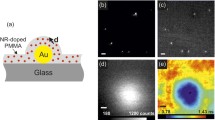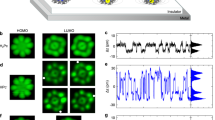Abstract
In this short letter, we describe the effects of low temperature on the Metal-Enhanced Fluorescence (MEF) phenomenon. Fluorophores close to Silver Island Films (SiFs) show on average two- to ten-fold enhancements in their fluorescence signatures at room temperature. However, at 77 K, we have observed that MEF is even more pronounced as compared to an identical glass control sample. We also demonstrate that the further enhancements in MEF occur at low temperature over a range of visible wavelengths for different fluorophores, for both SiFs and 20 nm surface deposited gold colloids.



Similar content being viewed by others
References
Drexhage KH (1974) In: Wolfe E (ed) Progress in Optics. North-Holland, Amsterdam, pp 161–232
Pettinger B, Gerolymatou A (1984) Dyes adsorbed at Ag–colloids—substitution of fluorescence by similarly efficient surface fluorescence and surface Raman-scattering. Berichte Der Bunsen-Gesellschaft-Physical Chemistry Chemical Physics 88(4):359–363
Glass AM, Liao PF, Bergman JG, Olson DH (1980) Interaction of metal particles with absorbed dye molecules—absorption and luminescence. Opt Lett 5(9):368–370
Sokolov K, Chumanov G, Cotton TM (1998) Enhancement of molecular fluorescence near the surface of colloidal metal films. Anal Chem 70(18):3898–3905
Gersten J, Nitzan A (1981) Spectroscopic properties of molecules interacting with small dielectric particles. J Chem Phys 75(3):1139–1152
Geddes CD, Lakowicz JR (2002) Metal-enhanced fluorescence. J Fluoresc 12(2):121–129
Gersten JI, (2004) Theory of fluorophore–metallic surface interactions, in Topics in Fluorescence Spectroscopy, vol. 8. In: Geddes CD, Lakowicz JR (eds) Springer, New York, pp 197–221
Lakowicz JR (2001) Radiative decay engineering: biophysical and biomedical applications. Anal Biochem 298(1):1–24
Dulkeith E, Ringler M, Klar TA, Feldmann J, MunozJavier A, Parak WJ (2005) Gold nanoparticles quench fluorescence by phase induced radiative rate suppression 5:585–589
Aslan K, Gryczynski I, Malicka J, Matveeva E, Lakowicz JR, Geddes CD (2005) Metal-enhanced fluorescence: an emerging tool in biotechnology. Curr Opin Biotechnol 16(1):55–62
Chowdhury MH, Aslan K, Malyn SN, Lakowicz JR, Geddes CD (2006) Metal-enhanced chemiluminescence: radiating plasmons generated from chemically induced electronic excited states. Appl Phys Lett 88:173104
Zhang Y, Aslan K, Previte MJR, Malyn SN, Geddes CD (2006) Metal-enhanced phosphorescence: interpretation in terms of triplet-coupled radiating plasmons. J Phys Chem, B 110(49):25108–25114
Zhang Y, Aslan K, Previte MJ, Geddes CD (2006) Metal-enhanced S2 fluorescence from azulene. Chem Phys Lett 432(4–6):528–532
Zhang Y, Aslan K, Previte MJ, Geddes CD (2007) Metal-enhanced fluorescence: surface plasmons can radiate a fluorophores structured emission. Appl Phys Lett 90:053107
Geddes CD, Gryczynski I, Malicka J, Gryczynski Z, Lakowicz JR (2004) Fluorescence detection gains in sensitivity. Photonics Spectra 38(2):92–99
Liebermann T, Knoll W (2000) Surface-plasmon field-enhanced fluorescence spectroscopy. Colloids and Surfaces A-Physicochemical and Engineering Aspects 171(1–3):115–130
Aslan K, Leonenko Z, Lakowicz JR, Geddes CD (2005) Annealed silver-island films for applications in metal-enhanced fluorescence: interpretation in terms of radiating plasmons. J Fluoresc 15(5):643–654
Lakowicz JR (2005) Radiative decay engineering 5: metal-enhanced fluorescence and plasmon emission. Anal Biochem 337(2):171–194
Aslan K, Malyn SN, Geddes CD (2007) Metal-enhanced fluorescence from gold surfaces: angular dependent emission. J Fluoresc 17(1):7–13
See KC, Spicer JB, Brupbacher J, Zhang D, Vargo TG (2005) Modeling interband transitions in silver nanoparticle–fluoropolymer composites 109:2693–2698
Wang H, Tam F, Grady NK, Halas NJ (2005) Cu nanoshells: effects of interband transitions on the nanoparticle plasmon resonance 109:18218–18222
Malicka J, Gryczynski I, Geddes CD, Lakowicz JR (2003) Metal-enhanced emission from indocyanine green: a new approach to in vivo imaging. J Biomed Opt 8(3):472–478
Aslan K, Geddes CD (2005) Microwave-accelerated metal-enhanced fluorescence: platform technology for ultrafast and ultrabright assays. Anal Chem 77(24):8057–8067
Yguerabide J, Yguerabide EE (1998) Light-scattering submicroscopic particles as highly fluorescent analogs and their use as tracer labels in clinical and biological applications—I. Theory. Anal Biochem 262(2):137–156
Cheng PP, Silvester D, Wang G, Kalyuzhny G, Douglas A, Murray RW (2006) Dynamic and static quenching of fluorescence by 1–4 nm diameter gold monolayer-protected clusters. J Phys Chem B 110(10):4637–4644
Jennings TL, Singh MP, Strouse GF (2006) Fluorescent lifetime quenching near <i>d </i> = 1.5 nm gold nanoparticles: probing NSET Validity 128:5462–5467
Dulkeith E, Morteani AC, Niedereichholz T, Klar TA, Feldmann J, Levi SA, van Veggel FC, Reinhoudt DN, Moller M, Gittins DI (2002) Fluorescence quenching of dye molecules near gold nanoparticles: radiative and nonradiative effects. Physical Review Letters 89(20):203002
Acknowledgement
The authors would also like to thank UMBI/MBC and the IoF for salary support.
Author information
Authors and Affiliations
Corresponding author
Rights and permissions
About this article
Cite this article
Zhang, Y., Aslan, K., Previte, M.J.R. et al. Low Temperature Metal-Enhanced Fluorescence. J Fluoresc 17, 627–631 (2007). https://doi.org/10.1007/s10895-007-0235-8
Received:
Accepted:
Published:
Issue Date:
DOI: https://doi.org/10.1007/s10895-007-0235-8




